Acrylic paint is a popular medium among artists due to its versatility, vibrant colors, and quick drying time.
But, does acrylic paint dissolve in water?
Well, this is one common question that arises to everyone who are directly involved in this space.
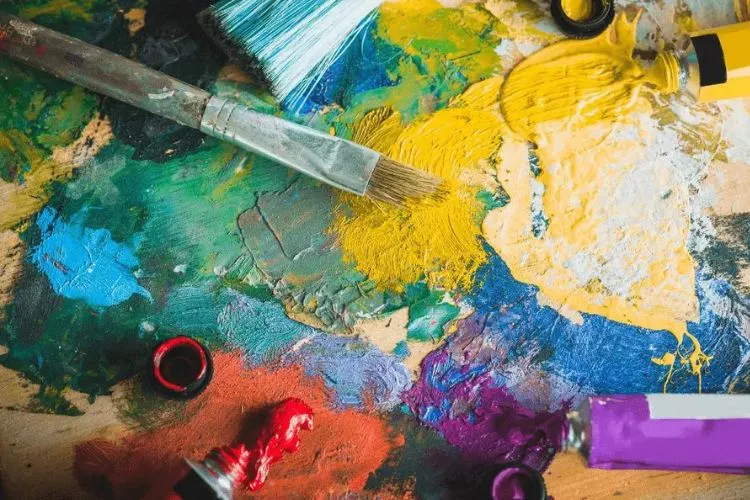
In this comprehensive guide, we will explore the solubility of acrylic paint, its properties, and how water can be used with acrylic paints to achieve various effects.
Understanding Acrylic Paint
Acrylic paint is a water-based paint composed of pigment particles suspended in an acrylic polymer emulsion. This composition gives acrylic paints their unique characteristics.
They are known for their quick drying time, water resistance, and durability once dry. Acrylic paints are used in various artistic applications, including painting on canvas, wood, paper, and even fabrics.
Does Acrylic Paint Dissolve in Water? Water Solubility of Acrylic Paint
When acrylic paint is wet, it is water-soluble. This means that water can be used to thin the paint, creating transparent washes or achieving desired consistency.
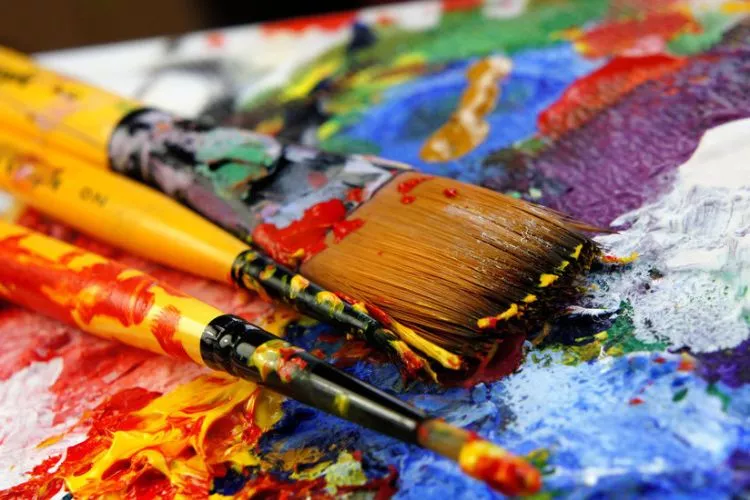
Water can also be used to clean brushes and palettes during the painting process, making it convenient for artists.
However, once the acrylic paint dries, it becomes water-resistant and forms a polymer film that bonds to the surface.
This property ensures the longevity of the artwork and protects it from moisture, making it suitable for different environments. It also means that once dry, acrylic paint does not dissolve in water.
Methods to Dissolve Acrylic Paint
There are several methods to dissolve or remove dry acrylic paint if needed:
Isopropyl Alcohol: Isopropyl alcohol, also known as rubbing alcohol, can be effective in dissolving dry acrylic paint. It is commonly used to remove small unwanted paint marks or to clean brushes and palettes.
However, it is important to test it on a small, inconspicuous area first to ensure it does not damage the surface or underlying layers.
Acrylic Airbrush Cleaning Products: Some commercially available acrylic airbrush cleaning products are designed to dissolve dry acrylic paint.
While these products are primarily meant for removing paint from airbrushes, they can be used cautiously to remove acrylic paint from surfaces and tools. Always follow the instructions provided by the specific product to ensure safe and effective use.
Correcting Mistakes with Opaque Paints: If you need to correct mistakes or unwanted paint marks, one method is to apply opaque acrylic paint over the area. Opaque paint colors can effectively cover and correct any imperfections without affecting the underlying layers.
This approach is particularly useful when working with a textured surface or when the original paint layer cannot be dissolved without damaging the artwork or surface.
It’s important to note that when using any of these methods, it is always recommended to test them on a small, inconspicuous area first to ensure they are suitable for the particular surface or material.
Additionally, take proper safety precautions such as working in a well-ventilated area and wearing appropriate gloves and eye protection when handling solvents.
Tips for Working with Acrylic Paints and Water
To achieve the best results when using acrylic paints with water, consider the following tips:
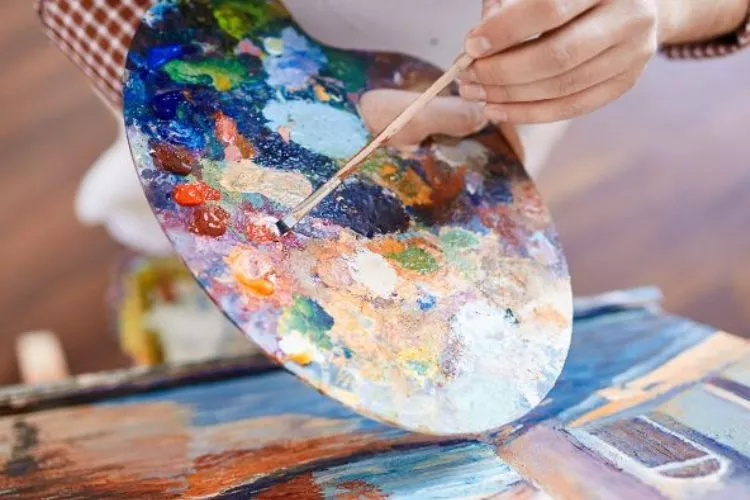
Proper Mixing Ratios: When thinning acrylic paint with water, it is important to find the right balance.
Start with a small amount of water and gradually add it to the paint until you achieve the desired consistency. It’s easier to thin paint with water than to thicken it, so proceed slowly.
Achieving Various Effects with Water: Experimenting with water and acrylic paints can result in interesting effects.
For example, adding water to acrylic paint can create a translucent wash or glaze, adding depth and luminosity to the artwork. Spraying water onto the paint can create droplet textures and interesting patterns.
Techniques for Controlling Water Effects: Different techniques can be employed to control the water effects when working with acrylic paints. For example, wet-on-wet techniques involve applying wet paint onto a wet surface to achieve blending and soft transitions.
Wet-on-dry techniques involve applying wet paint onto a dry surface, allowing for sharper details and layering effects.
Does dry acrylic paint dissolve in water?
No, dry acrylic paint does not dissolve in water. Once acrylic paint dries, it forms a water-resistant polymer film that adheres to the surface.
This property is what makes acrylic paints durable and long-lasting. While water can be used to thin or dilute wet acrylic paint and create transparent washes, once the paint dries, it becomes insoluble in water.
This is different from watercolor paints, which remain water-soluble even after drying. To remove dry acrylic paint, solvents like isopropyl alcohol or specialized acrylic cleaning products can be used, as mentioned earlier.
Do you use water with acrylic paint on canvas?
Yes, water is commonly used with acrylic paint on canvas. Water can be added to acrylic paint to thin it down, create transparent washes, or achieve various effects.
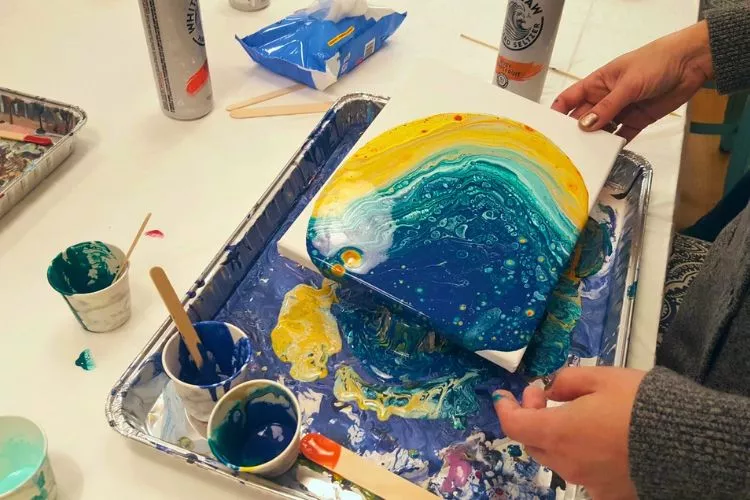
Adding water to acrylic paint allows artists to control the consistency and viscosity of the paint. It can also help with blending and layering colors, creating smooth transitions, and creating textured effects.
Additionally, water is used to clean brushes and palettes during the painting process, making it easier for artists to work with acrylic paints.
Can you mix water with acrylic paint for pouring?
Yes, water can be mixed with acrylic paint for pouring techniques. Acrylic pouring involves creating abstract or fluid art by pouring or dripping different colors of acrylic paint onto a canvas or other suitable surface.
Water is commonly used as a pouring medium to help thin down the paint and improve its flow. When combined with water, acrylic paints become more fluid and easily pourable.
The addition of water also allows for better mixing of colors and helps create interesting patterns and effects as the paint flows and interacts on the canvas.
Keep in mind that the desired consistency and ratio of paint to water may vary depending on the specific pouring technique being used.
Can you mix acrylic paint with water to make watercolor?
While acrylic paint and watercolor paint are both water-based, they have distinct differences. Acrylic paint cannot be mixed with water to create traditional watercolor paint.
Watercolor paints are made with pigments that are often more transparent and can be reactivated or diluted with water even after they have dried. In contrast, acrylic paint forms a permanent and water-resistant film once dry and cannot be reactivated with water.
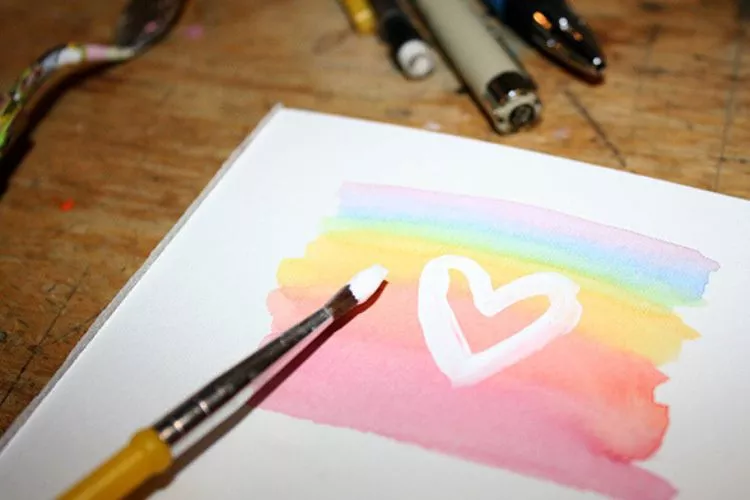
However, artists can create watercolor-like effects using acrylic paints by diluting them with water.
When acrylic paint is thinned with water, it can create transparent washes and glazes that resemble the transparency and luminosity of watercolor.
This technique allows artists to achieve similar effects to watercolor painting while benefiting from the versatility and durability of acrylics.
Frequently Asked Questions (FAQs)
Can you remove dried acrylic paint with water?
No, once acrylic paint has dried, it forms a water-resistant polymer film and does not dissolve in water. However, solvents like isopropyl alcohol or specialized acrylic airbrush cleaning products can be used for removal.
Can you wash off acrylic paint from skin with water?
Yes, wet acrylic paint can be easily washed off from the skin with water and mild soap. However, once dry, it becomes more challenging to remove.
How does acrylic paint compare to oil paint in terms of water solubility?
Unlike acrylic paint, oil paint is not water-soluble. It requires solvents such as turpentine or mineral spirits for thinning, cleaning, and removal.
How Water Affects the Texture and Finish of Acrylic Paint
Water plays a crucial role in modifying the texture and finish of acrylic paint, allowing artists to explore a variety of techniques and achieve unique visual effects.
Creating Texture with Water
One of the most exciting possibilities when working with acrylic paint and water is the ability to create texture. By varying the water-to-paint ratio, artists can manipulate the thickness and texture of the paint.
Adding more water will thin the paint, making it more fluid and allowing for smooth, transparent washes. On the other hand, using less water or no water at all can create thicker, more textured layers.
Another way to create texture is by using water in combination with different tools. For example, spraying water onto a painted surface while it’s still wet can cause the paint to lift, creating a spontaneous, textured effect.
Similarly, adding more water to acrylic paint can help achieve a watercolor-like appearance with soft, diffused edges.
Enhancing Glazes and Layers
Water can also be used to create glazes, a technique that involves applying thin, transparent layers of paint over dry layers.
The addition of water allows for smooth, even application while enhancing the depth and luminosity of the colors. This technique is commonly used in portraiture, still life, and other detailed works to add richness and complexity to the painting.
Controlling Drying Time
Acrylic paint dries quickly, but adding water can slightly extend the drying time, giving artists more time to blend and adjust colors. This is particularly useful for creating smooth transitions or soft edges in a painting.
However, be cautious not to add too much water, as it can cause the paint to become too runny, losing its color intensity and coverage.
Conclusion:
Acrylic paint, while water-soluble when wet, becomes water-resistant once dry.
Understanding the properties of acrylic paint and its interaction with water allows artists to unlock the vast potential of this versatile medium.
By experimenting with water and employing various techniques, artists can achieve a wide range of effects.
Although acrylic paint does not dissolve in water once dry, solvents and correctives can be used to address mistakes or remove unwanted paint marks.
Overall, knowing how to work with acrylic paint and water opens up countless possibilities for creative expression.

Meet Isabella Anderson, your acrylic painting mentor with over a decade of brush-wielding mastery. Dive into the colorful world of acrylics with her expert guidance, featured exclusively on ‘Acrylic Authority.’ Unleash your inner artist and explore the limitless possibilities of this versatile medium alongside a true acrylic aficionado.
